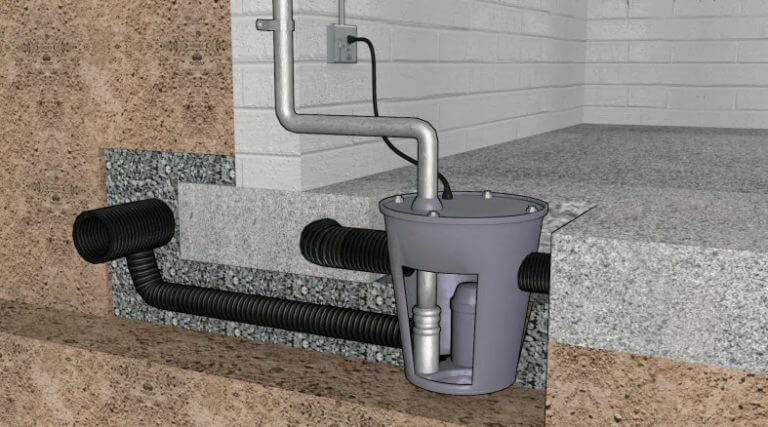When it comes to protecting your home from water damage, sump pumps are unsung heroes that work diligently behind the scenes. These unassuming devices play a pivotal role in safeguarding your basement or crawl space from flooding and moisture-related issues.
For a comparative low cost you can get an installation of a device that will collect water that makes it to your basement and will effectively remove it. These are often a part of interior basement waterproofing services.
The Battle Against Water Intrusion
Water intrusion is a common and persistent threat to the structural integrity and livability of homes. It can occur for various reasons, including heavy rainfall, rising groundwater levels, plumbing leaks, and even natural disasters. Left unchecked, water infiltration can lead to –
A flooded basement is not only inconvenient but can also result in extensive damage to your possessions, interior finishes, and the structural components of your home. Excess moisture in the basement or crawl space creates an ideal breeding ground for mold and mildew. These fungi can compromise indoor air quality and pose health risks.
Water can undermine the foundation of your home, leading to cracks, settlement, and structural instability. Property price may be impacted as water damage and a history of flooding can significantly reduce the value of your property and make it less appealing to potential buyers.
The Role of Sump Pumps
Sump pumps are your first line of defense against basement or crawl space flooding. These devices are typically installed in a pit or basin, known as a sump pit, which collects water that enters the space. When the water level in the pit reaches a certain point, the sump pump activates, pumping the water out and away from your home. Here’s why sump pumps are indispensable for crawlspace and basement waterproofing.
Sump pumps actively prevent flooding by swiftly removing excess water as it enters the sump pit. This prevents water from rising and damaging your home’s interior. Even if your basement or crawl space is not prone to flooding, sump pumps help control moisture levels by removing groundwater and preventing it from seeping through the foundation walls.
By keeping your space dry, sump pumps significantly reduce the risk of mold and mildew growth, which can lead to health problems and costly remediation. Water pressure from rising groundwater or excess moisture can exert tremendous force on foundation walls. Sump pumps relieve this hydrostatic pressure, safeguarding your foundation from damage.
Sump pumps protect your possessions, such as furniture, electronics, and valuables, from water damage and potential loss. Knowing that a sump pump is standing guard in your basement or crawl space provides peace of mind, especially during heavy rainstorms or periods of high groundwater levels.
Types of Sump Pumps
Sump pumps come in various types to suit different needs and conditions. The two primary categories are:
- Submersible Sump Pumps – Submersible pumps are installed inside the sump pit, submerged in water. They are more discreet and quieter than pedestal pumps. Submersible pumps are well-suited for high-capacity applications and continuous use.
- Pedestal Sump Pumps – Pedestal pumps are mounted on a pedestal above the sump pit. While they are more visible and less discreet, they are easier to access for maintenance and repairs. Pedestal pumps are suitable for lower-capacity applications and occasional use.
Sump Pump Maintenance
To ensure the reliability and effectiveness of your sump pump, regular maintenance is essential. Here are some maintenance tasks to keep in mind –
- Check the Float Switch – The float switch is responsible for activating the pump when the water level rises in the sump pit. Ensure that it moves freely and is not obstructed by debris.
- Clean the Sump Pit – Periodically remove any debris, mud, or sediment that may accumulate in the sump pit. A clean pit allows the pump to function optimally.
- Test the Pump – Test your sump pump by pouring water into the pit to simulate rising water levels. Verify that the pump activates and pumps the water out efficiently.
- Inspect the Discharge Pipe – Ensure that the discharge pipe is clear of obstructions and directs water away from your home’s foundation. This prevents water from recirculating into the pit.
- Replace Backup Batteries – If your sump pump has a battery backup system, replace the batteries as recommended by the manufacturer. Backup power is crucial during power outages.
- Professional Inspection – Consider scheduling a professional inspection of your sump pump system every couple of years. Experts can identify issues that may not be apparent during routine checks.
Sump pumps are unsung heroes in the battle against water intrusion and flooding in your home. These unassuming devices work diligently to protect your basement or crawl space from the potentially devastating effects of water damage, mold growth, and foundation problems, saving you thousands of dollars in concrete repairs, renovations and property value. Investing in a reliable sump pump and performing regular maintenance can provide you with the peace of mind that your home is safeguarded against the unpredictable forces of nature.
Sump pump installation can be a relatively affordable way to prevent some serious damage to your property.

